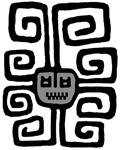Center, Textile Research

PreColumbian Textile Conference VIII / Jornadas de Textiles PreColombinos VIII (2019)
Date of this Version
6-2020
Document Type
Article
Citation
DOI: 10.32873/unl.dc.zea.1206
Published in PreColumbian Textile Conference VIII / Jornadas de Textiles PreColombinos VIII, ed. Lena Bjerregaard and Ann Peters (Lincoln, NE: Zea Books, 2020). https://digitalcommons.unl.edu/zeabook/
Abstract
Las formas habituales de los tejidos son la cuadrangular o la rectangular. Sin embargo, existen casos de tejidos como los paños trapezoidales de algodón usados como prendas de vestir (taparrabos, turbantes, pañuelos). Aquí presentamos un estudio de una prenda de forma triangular hallada en Pachacámac. Su hallazgo no recibió mayor atención, pese a su gran dimensión y la manera de cómo ha sido confeccionada, es muy particular: sus bordes están recamados de plumas anaranjadas y moradas en hileras. Explicaremos la confección de cada una de sus partes, haremos comparaciones con otras vestimentas de forma similar, y propondremos las posibles funciones que pudo tener este tejido triangular con plumas en su contexto.
The most frequent shape of textiles is either quadrangular or rectangular. However, there are cotton textiles in trapezoidal form worn as personal attire (loincloths, scarves, turbans). We present here a study of a piece in triangular shape from Pachacámac, which has not been analyzed before. Its dimension and its manufacture are peculiar: its hems were decorated with orange and purple feathers in rows. We will explain the making of each section, compare it with other triangular garments, and illustrate the possible functions of such a textile in its context.
Les formes habituelles des tissus sont quadrangulaires ou rectangulaires. Cependant, il existe des tissus en coton de forme trapézoïdale utilisés comme vêtements (pagnes, turbans, étoffes). Nous présentons ici une étude d’un tissu de forme triangulaire découvert à Pachacamac qui n’a pas été analysé auparavant. Ses dimensions et la manière dont il a été confectionné sont particulières : ses bords ont été décorés de plumes orangées et mauves disposées en bandes. Nous expliquons l’élaboration de chacune de ses parties, en le comparant à d’autres formes de vêtements similaires, et nous proposons les possibles fonctions qu’a pu avoir ce tissu triangulaire à plumes selon son contexte.
Included in
Art and Materials Conservation Commons, Fiber, Textile, and Weaving Arts Commons, Indigenous Studies Commons, Latin American Languages and Societies Commons, Museum Studies Commons, Other History of Art, Architecture, and Archaeology Commons


Comments
Copyright 2020 Lourdes Chocano Mena